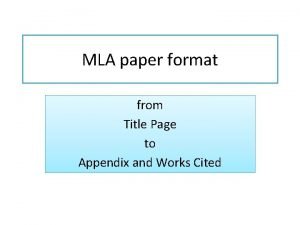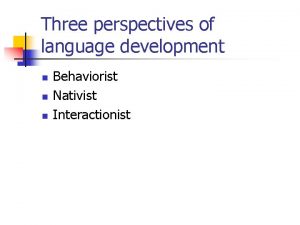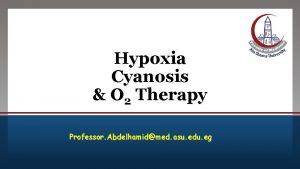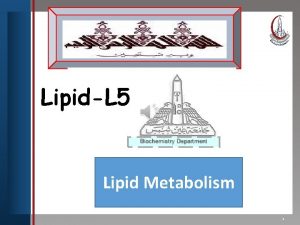Click to edit Master title style Click to































- Slides: 31

Click to edit Master title style Click to edit Master text styles Second level Third level Fourth level Fifth level Marsha Regenstein, Ph. D, Director

The Changing Face of America In the U. S. , one in five people speak a language other than English Chart: Percentage of population age five and older by language spoken at home The total population age 5 and older in the United States was 279, 012, 712 in 2006 Source: U. S. Census Bureau 2006. http: //factfinder. census. gov, table S 1601 “Language Spoken at Home”

Patients are Increasingly Diverse and Multicultural • More than 24 million individuals speak English “less than very well” and are thus said to be limited English proficient (LEP). Source: U. S. Census Bureau 2006. http: //factfinder. census. gov, table S 1601 “Language Spoken at Home”.

Risk factors associated with LEP population: • Persons with LEP experience disproportionately high rates of infectious disease and infant mortality. • Persons with LEP are more likely to report risk factors for serious and chronic diseases such as diabetes and heart disease. Source: Office of Minority Health, “Eliminating Racial and Ethnic Disparities, ” http: //www. cdc. gov/omh/About. Us/disparities. htm (25 April 2007)

Patients who do not speak English as their primary language have greater problems with communication Source: The Commonwealth Fund 2001 Health Care Quality Survey, chart 11.

Non-English* speakers have more difficulty understanding information from their doctor’s office * English is not primary language spoken at home Source: The Commonwealth Fund 2001 Health Care Quality Survey, chart 15.

Language Barriers Negatively Impact Patient. Provider Communication Adults who report their health providers sometimes or never: listened carefully, explained things clearly, respected what they had to say, and spent enough time with them, 2003 Percentage of adults age 18 and over AI/AN = American Indian/Alaska Native Note: Percentages are adjusted for non-response based on how many of the four questions had a response. Source: Agency for Healthcare Research and Quality. National Healthcare Disparities Report. 2006.

Language barriers affect patients’ quality of care • Language barriers are associated with less health education, worse interpersonal care, and lower patient satisfaction. Source: Ngo-Metzger Q, Sorkin DH, Phillips RS, et al. J Gen Intern Med 2007. 22(Suppl 2): 324– 30 • Hispanics who do not speak English at home are less likely to receive all recommended health care services. Source: Cheng EM, Chen A, Cunningham, W. J Gen Intern Med 2007. 22(Suppl 2): 283– 8.

Language barriers affect patients’ quality of care: • LEP patients who are hospitalized are less likely to have documentation of informed consent before undergoing invasive procedures. Source: Schenker Y, Wang F, Selig SJ et al. J Gen Intern Med 2007. 22(Suppl 2): 294– 9 • LEP populations are less likely to receive preventative health services such as mammograms. Source: Woloshin S, Schwartz LM, Katz SJ, Welch HG. Is language a barrier to the use of preventive services? J Gen Intern Med. 1997; 12: 472– 477.

Language barriers affect patients’ participation in care • For LEP populations, follow-up compliance, adherence to medications, and patient satisfaction are significantly lower than they are for English-speaking patients. Sources: Ku, L. How race/ethnicity, immigration status and language affect health insurance coverage, access to care and quality of care among the low-income population. Washington, DC: Kaiser Family Foundation, August 2003. [1] Andrulis, D, Goodman N, Pryor N. What a difference an interpreter can make: Health care experiences of uninsured with limited English proficiency. Boston, MA: The Access Project, April 2003. [1] David RA, Rhee B. The impact of language as a barrier to effective health care in an underserved urban Hispanic community. Mt Sinai J Med, 1998; 65(5, 6): 393 -397

Negative outcomes of ineffective communication: • Doctors who are unable to communicate effectively with their patients often compensate by engaging in costly practices such as § more diagnostic procedures § more invasive procedures § overprescribing medications. Source: Ku L, Flores G. Pay now or pay later: providing interpreter services in health care. Health Aff 2005 Mar-Apr; 24(2): 435 -44.

Negative outcomes of ineffective communication § Adverse events occurring during hospitalization have been shown to be more severe and more likely to be related to communication problems in LEP patients than for English-speaking patients. Source: Divi C, Koss RG, Schmaltz SP, et al. Language proficiency and adverse events in U. S. hospitals: A pilot study. Int J Qual Health Care 2007 Apr; 19(2): 60 -7

Hospitals use a variety of resources to provide interpreters Methods Commonly Used In U. S. Hospitals To Provide Language Services Source: Health Research and Educational Trust, 2006 Does not total 100%. Respondents were asked to check “all that apply”

Patients who need an interpreter do not always get a trained medical interpreter Use of Interpreter Services in U. S. Healthcare Settings*: Of patients who say they need an interpreter, percentage who report they “always or usually” get some form of interpreter assistance 48% Usual interpreter method was: Staff member 53% Friend or family member Trained medical interpreter *Survey results from patients Source: The Commonwealth Fund 2001 Healthcare Quality Survey, chart 21 43% 1%

Use of Staff in Language Services § Self-reported bilingual staff should be screened for proficiency in medical encounters • About one in five dual-role staff interpreters at a large health care organization had insufficient bilingual skills to serve as interpreters in a medical encounter. Source: Moreno MR, Otero-Sabogal R, Newman J. J Gen Intern Med 2007. 22(Suppl 2): 331– 5

Use of untrained medical interpreter or no interpreter impairs communication quality • Ad hoc interpreters misinterpreted or omitted up to half of physicians’ questions. Source: Ebden P, Carey OJ, Bhatt A et al. The bilingual consultation. Lancet 1988, 1: 347 • Errors committed by ad hoc interpreters were significantly more likely to be errors of potential clinical consequence than those by hospital interpreters. Source: Flores G, Laws MD, Mayo SJ et al. Errors in medical interpretation and their potential clinical consequences in pediatric encounters. Pediatrics 2003, 116: 6 -14.

Effects of Language Services on Patient Care LEP patients’ understanding of disease and treatment plans were significantly more likely to be poor or fair compared to those who were provided an interpreter. Percentage of patients

Effects of Language Services on Patient Care • Compared with LEP patients who are not provided with an interpreter, LEP patients who are provided with an interpreter give higher satisfaction scores and utilize more primary care services such as: • Schedule more outpatient visits • Fill more prescriptions Source: Jacobs EA, Lauderdale DS, Meltzer D, et al. Impact of interpreter services on delivery of health care to limited English-proficient patients. J Gen Intern Med 2001 July; 16(7): 468 -74; Kuo D, Fagan MJ. Satisfaction with methods of Spanish interpretation in an ambulatory care clinic. J Gen Intern Med 1999 Sep; 14(9): 647 -50

Effects of Language Services on Patient Care Patients provided with concordant or professional interpreter services are more satisfied with their medical provider than those patients who used family or untrained staff. Percentage satisfied Source: Lee LJ, Batal HA, Maselli JH, et al. J Gen Intern Med 2002, 17: 641 -46.

Cost of language services are not always prohibitive • One study found that creating a system of formally trained interpreter services in hospitals does not significantly affect hospital costs. • Same study also found that physician–patient language concordance reduces return ED visits. Source: Jacobs EA, SSadowski LS, Rathouz PJ. J Gen Intern Med 2007. 22(Suppl 2): 306– 11

The Challenge for Hospitals § All hospitals required to provide language services (interpreters, phone services, or video link) to LEP patients at no charge § Minimal federal guidance § No uniform standards for assessing the effectiveness of language services § Hospitals need answers: • How do we know if current services are meeting patient needs? • What institutions are doing it well, and how can we learn from them?

Survey response from hospitals Question: What type of barriers do you face in providing language services? Source: Health Research and Education Survey, 2006 Does not total 100%- respondents were asked to check “all that apply”.

Community level data is important to identify needs in a community Large percentage of hospitals maintain patients’ primary language in database. . . Source: Health Research and Educational Trust, 2006 Smaller percentage of hospitals actually track changes over time

Approaches used by hospitals to create policies and procedures for language services Source: Health Research and Education Survey, 2006 Does not total 100%- respondents were asked to check “all that apply”.

Speaking Together Project Goals § § To improve communication between patients with LEP and their health care providers. To work with hospitals to develop models of high-quality language services. To help hospitals develop useful, ongoing measures, enabling hospitals to create performance benchmarks and conduct measurements of performance. To share successful strategies to increase effective language services within and across hospitals and health systems

Institute of Medicine Domains of Quality Adapted for Language Services by Speaking Together Domain Principle Safe Avoiding injuries to patients from the language assistance that is intended to help them. Effective Providing language services based on scientific knowledge that contribute to all who could benefit, and refraining from providing services to those not likely to benefit. Patient. Centered Providing language assistance that is respectful of and responsive to individual patient preferences, needs, culture and values, and ensuring that patient values guide all clinical decisions. Timely Reducing waits and sometimes harmful delays for both those who receive and those who give care. Efficient Avoiding waste, including waste of equipment, supplies, ideas, and energy. Equitable Providing language assistance that does not vary in quality because of personal characteristics such as language preference, gender, ethnicity, geographic location, and socioeconomic status.

Background § National program sponsored by the Robert Wood Johnson Foundation (RWJF) as one of its Quality/Equality initiatives § Aims to improve quality of language services provided to patients at America’s hospitals § Addresses both racial/ethnic disparities and quality of clinical care–both areas of intensive focus for RWJF § Administered by a national program office at The George Washington University


Participating Hospitals: § Focus on improving: • An inpatient service • Two clinical outcomes (diabetes, heart disease or depression) + any general outcome with clinical significance § Receive technical assistance on how to use rapid cycle change to improve services § Participate in a learning network; share best practices § Learn how to collect data to assess results

Core Measures § § § Percentage of patients who have been screened for their preferred spoken language Percentage of LEP patients receiving initial assessment and discharge instructions from assessed and trained interpreters or from bilingual providers assessed for linguistic proficiency Percentage of encounters where the patient wait time is 15 minutes or less. Percentage of time interpreters spend providing medical interpretation with patients and providers Percentage of encounters where interpreters wait less than 10 minutes to provide language services to provider and patient.

Project Outcomes § Embed language services in hospital operations § Help hospitals continually assess and improve language services § Expand into additional clinical and service areas § Examine productivity and cost of interpreter services § Identify demand for language services § Build relationships across language services and other hospital components
 Click to edit master title style
Click to edit master title style Click to edit master title style
Click to edit master title style Click to edit master title style
Click to edit master title style Click to edit master title style
Click to edit master title style Hard edits
Hard edits Master title style
Master title style Master title style
Master title style Click clever click safe campaign
Click clever click safe campaign Click clever click safe
Click clever click safe Click clever click safe
Click clever click safe Safety click
Safety click Click to add title
Click to add title Click to add title
Click to add title Click to add title ne demek
Click to add title ne demek What is a slide-title master pair
What is a slide-title master pair Master title
Master title Daskolos
Daskolos Completing reports and proposals
Completing reports and proposals Title title
Title title How to do an appendix in mla
How to do an appendix in mla Chicago title page
Chicago title page Apa format in powerpoint
Apa format in powerpoint Informal tone
Informal tone Cumulative sentence
Cumulative sentence Formal vs informal style
Formal vs informal style Referential style vs. expressive style
Referential style vs. expressive style Modified business letter
Modified business letter Inversion in poem
Inversion in poem Https//formsgle/gxzmdteyrifdwq1p6 job
Https//formsgle/gxzmdteyrifdwq1p6 job Edit decision list
Edit decision list Ferik edit
Ferik edit Gene edit
Gene edit




















































